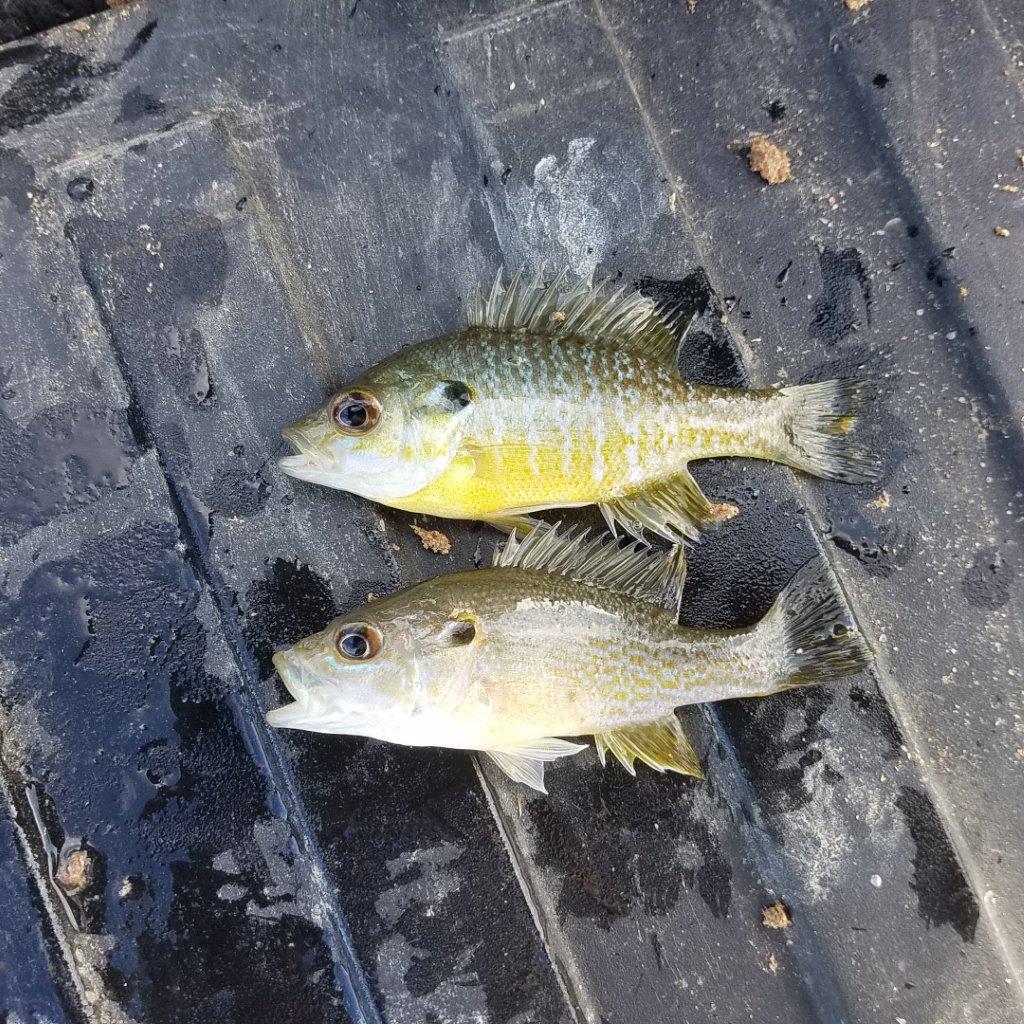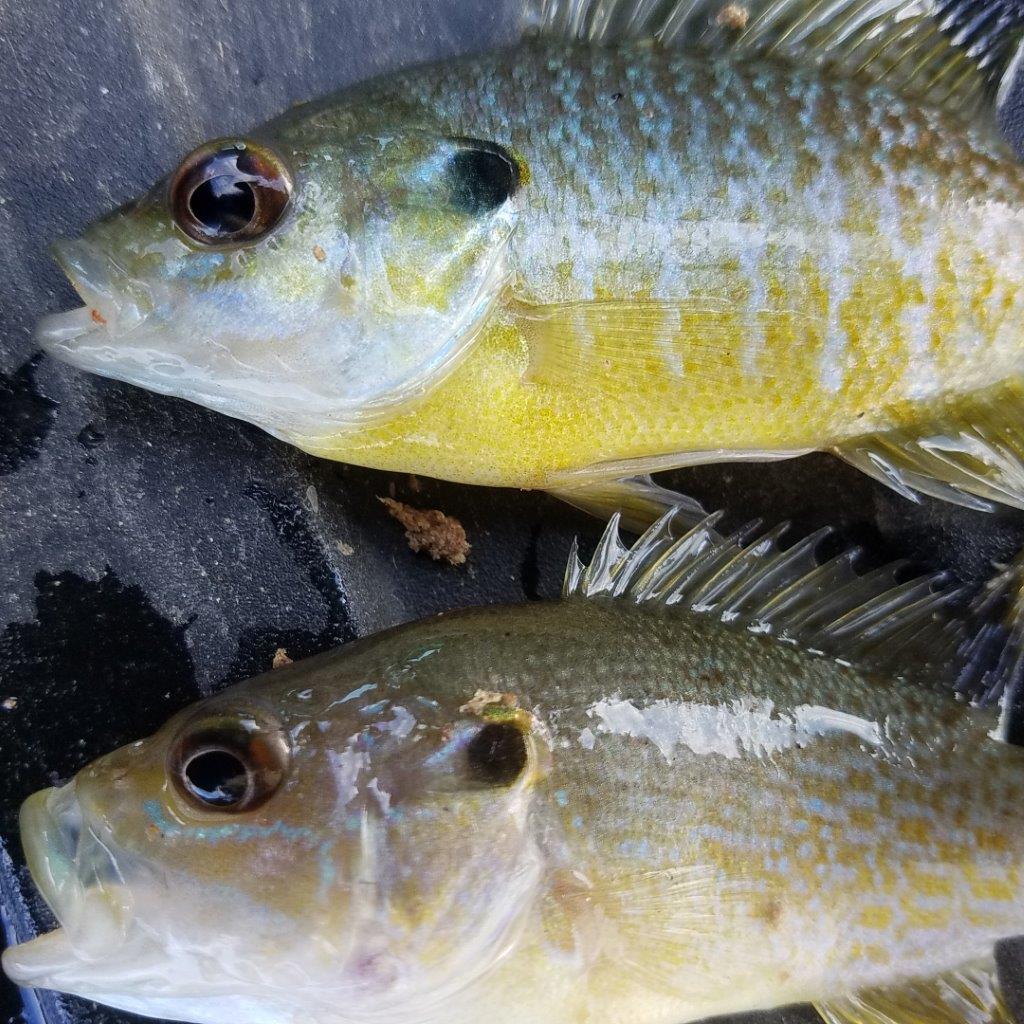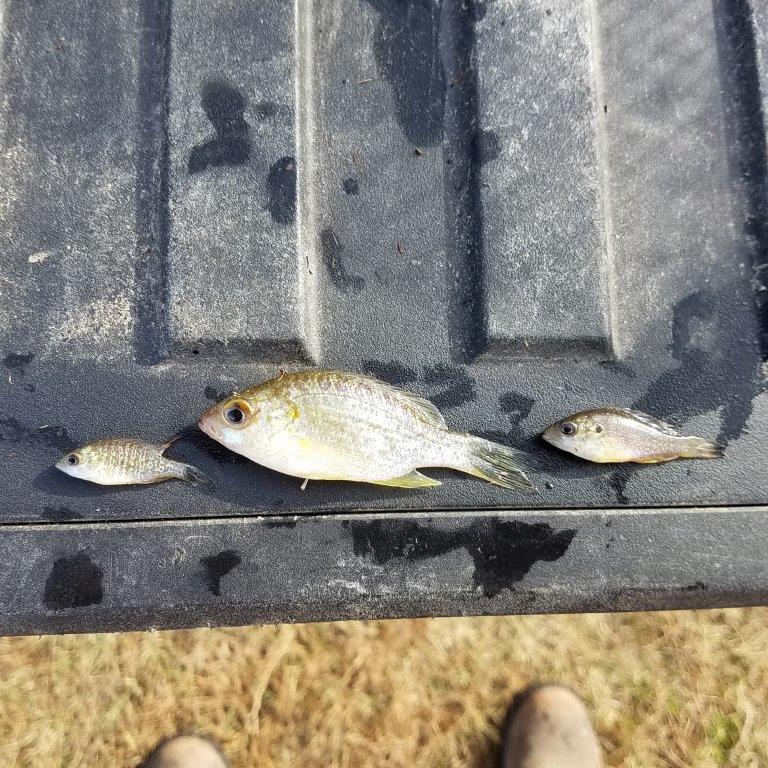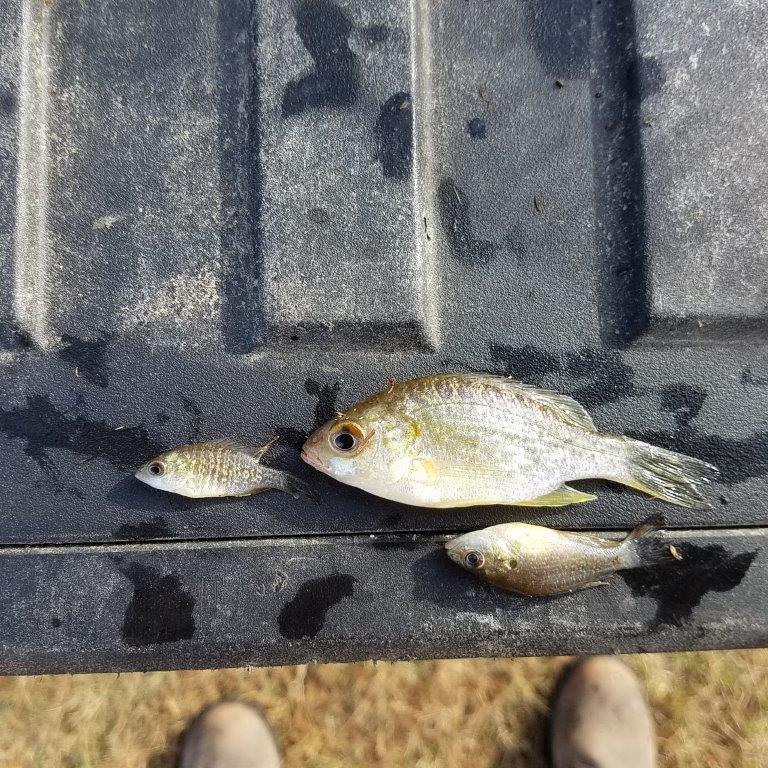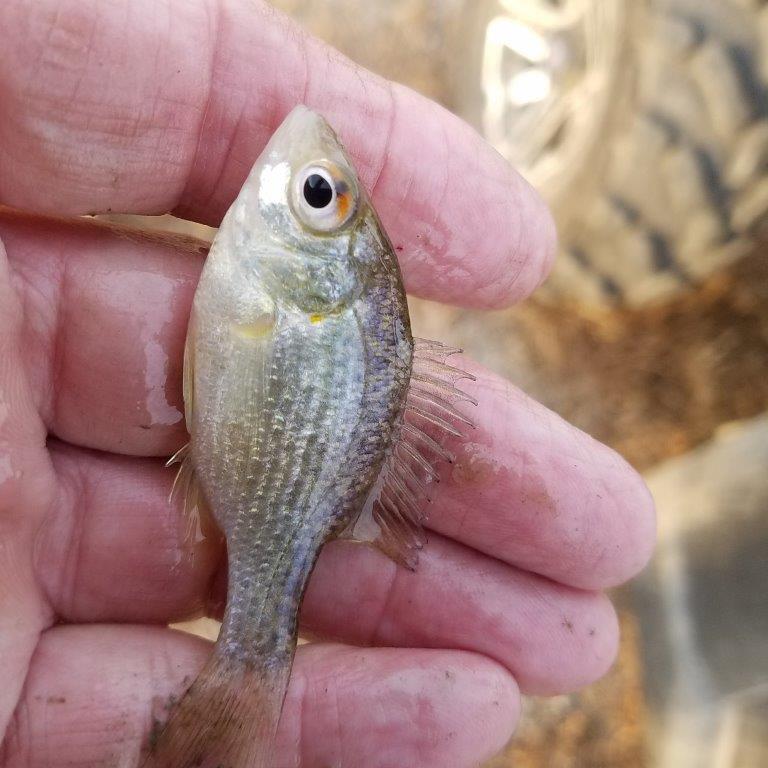Fingerling BG, HBG and GSF identification, RES too - 07/05/16 08:55 PM
I happen to pull up a minnow trap that had three fish about the same size I thought would be good to post to show the differences in fingerling BG, HBG and GSF.
These three fish came out of my sediment pond where I am getting a significant number of natural HBG spawn. I get the rare GSF fingerling, quite a few more of the HBG, a few RES, and lots and lots of CNBG from the original CNBG and RES stocked in this 1/10th acre sediment pond.
I will tell what I believe the fish to be in the first picture based on what I see. Then let the experts correct or add to my description of what they think they are. The rest of the pictures will be of the same three fish but in different order because they kept jumping around while I was trying to get pictures. My phone is an old one and does not take the greatest pictures, but I like using it because I do not have to resize them to get them to upload.
First picture the top fish is a BG (likely CNBG because that is what is stocked in this pond, but high water events do let my small northern BG swim up the overflow so the potential is there for it to be a regular BG but odds are against it).
First picture middle fish is one of a significant number of naturally occurring HBG I am getting from this pond. There were a few GSF snuck into this pond (I have caught a few adults) and have spawned with a BG. It is harder to tell from this picture on some of the features I will describe, but in person they were more evident. The mouth size of this fish is intermediate from the top and bottom fish. It has the vertical bars of a BG but notice the more elongated shape than the top BG. On the opercular tab there is a slight orange translucent border showing GSF influence as well as some less defined green bars below the eye reminiscent of a GSF.
First picture bottom fish is a classic GSF that I have seen and trapped hundreds that look exactly like this one from my old pond. More fusiform elongated shape, Large mouth compared to a BG (closer to the size of a LMB of that size), distinct green bars on the mouth area under the eye, No vertical bars except for the slight amount near the top of the fish. If you look closely, the bluegreen flecks the GSF is known for its coloration are actually lined horizontally. Though they are very small, there will be a horizontal line of mostly green flecks alternating with lines composed of the other colors of the fish. Notice the tinted lower fins, in this case reddish. Sometimes I also see a yellow tint to the fin borders on the larger GSF. Never see a tinted border on regular BG, although my larger CNBG tend to have a white border tint. But never reddish or yellow.
All the remaining pictures are the same fish (but not in the same order as they were jumping around) for more angles of view. Wish I was a professional photographer so the pics were better than they are. But I think you can see most of the differences in the fish. I also wish I would have had a fingerling RES and LMB in the same picture.
I'm guessing the fish to be about 2.5" long. This size readily goes into a standard 1" opening minnow trap. The high water from recent rains raised the water up enough so these fish along with a few others went in this trap that was left on the bank the night before. When I saw the three different fish together........... photo op!
I welcome additions and corrections to my descriptions.
Edit: notice the last picture description which was added later. RES pictures further down the thread in another post. Second edit: After seeing hundreds of both pure RES and RESxGSF hybrids, the picture is definitely a hybrid. I have raised these up to 8" now and the hybrid is more evident as the fish get older. Green bars on the cheeks are one giveaway.
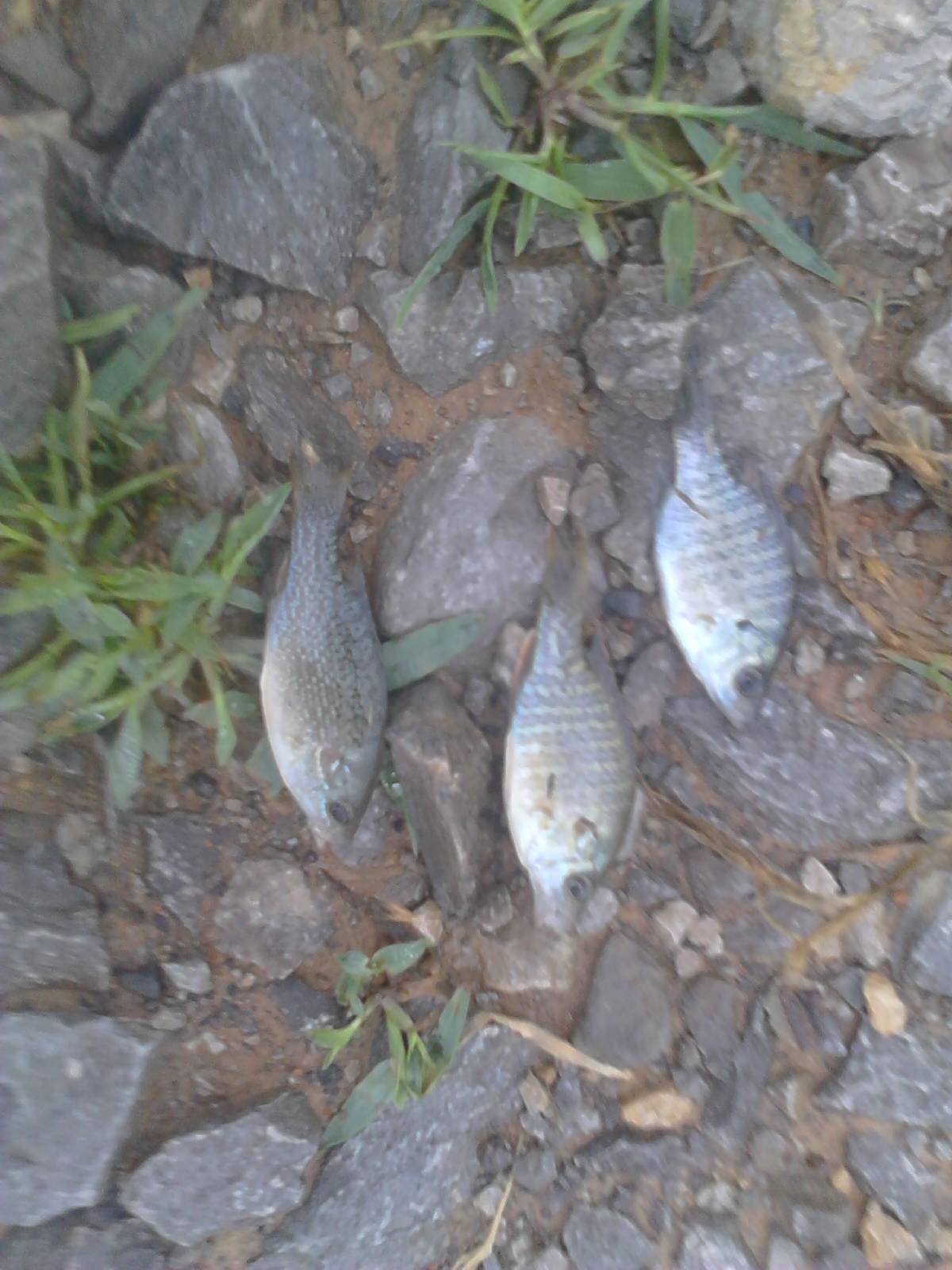
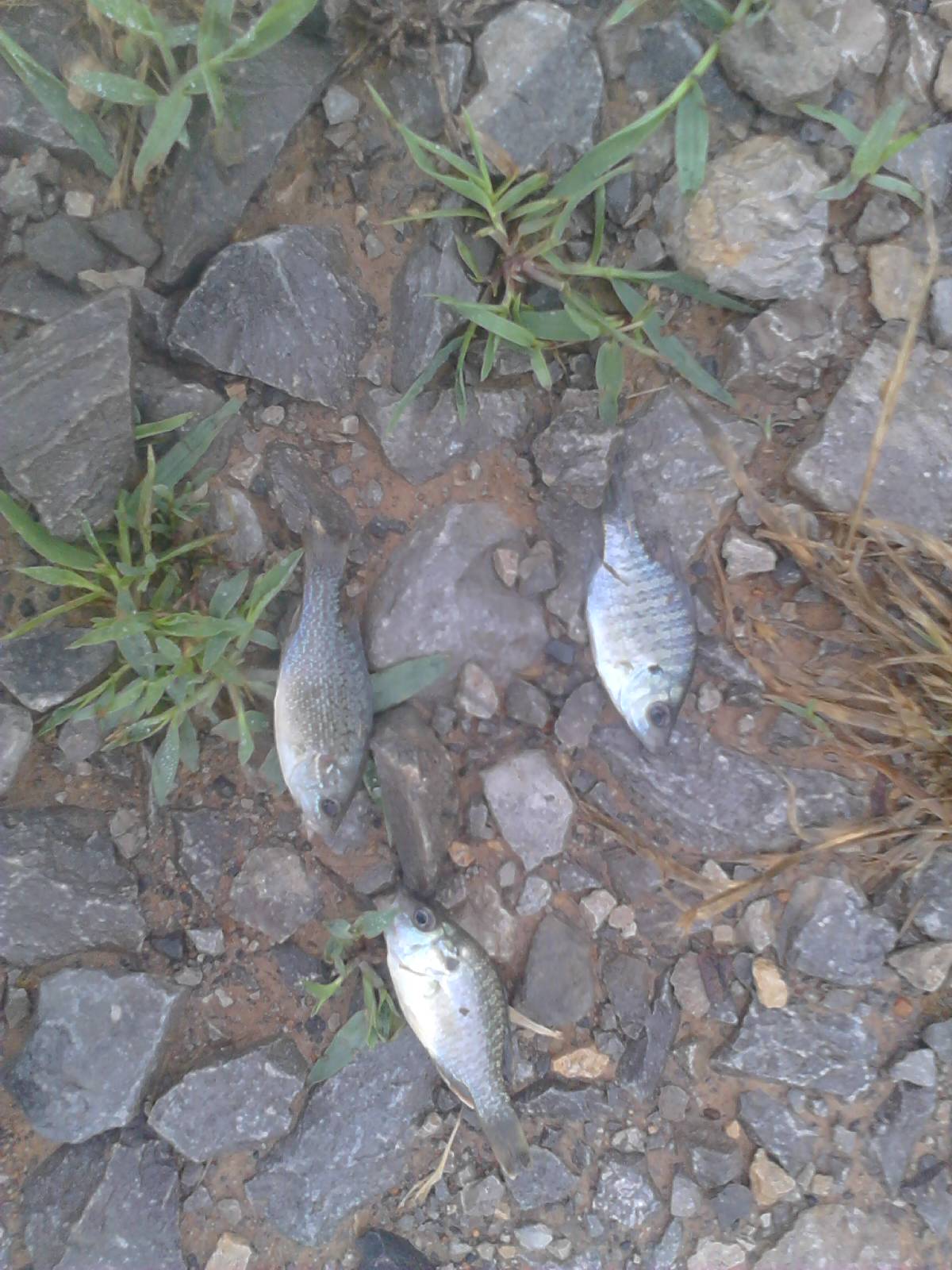
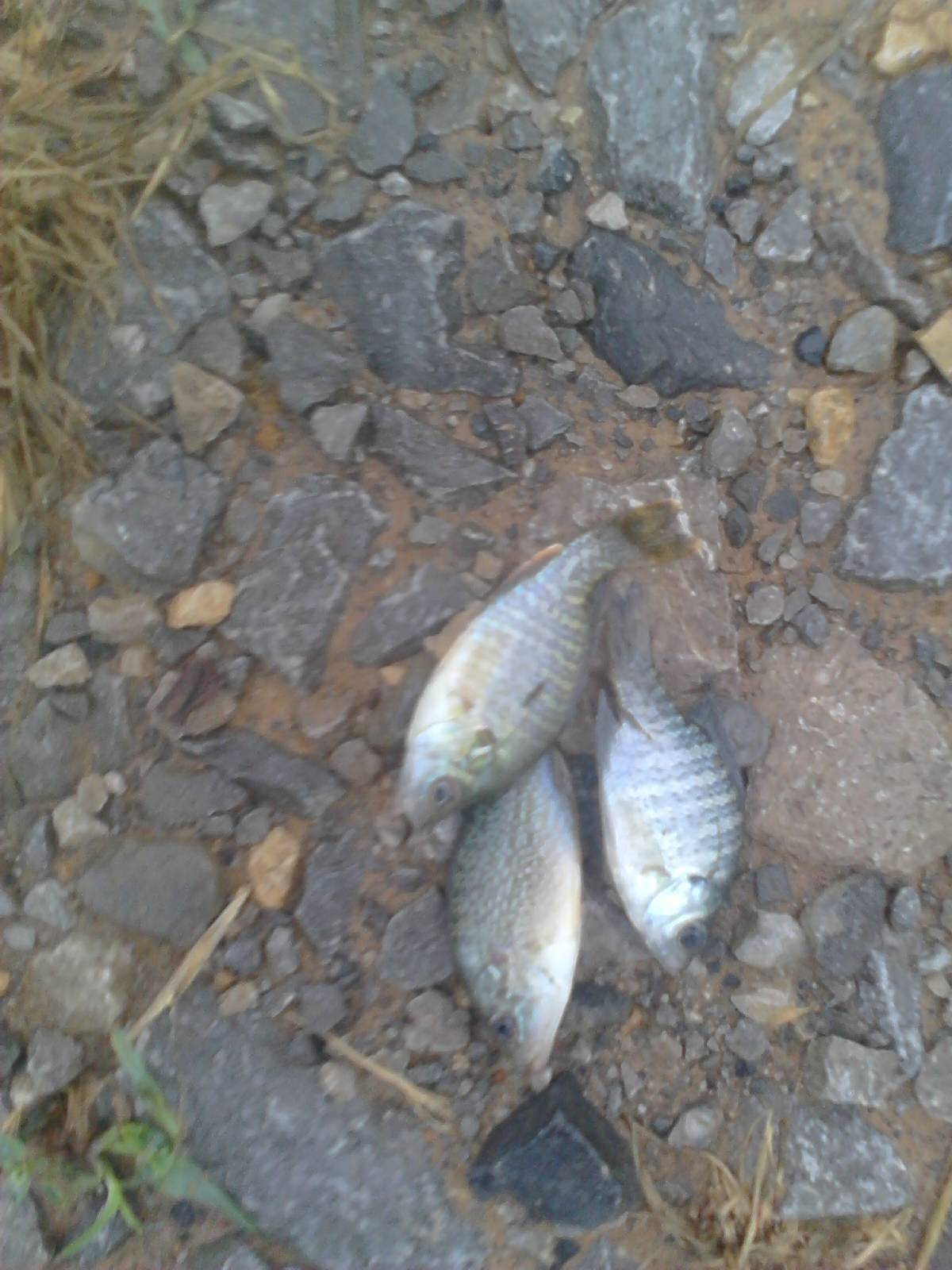

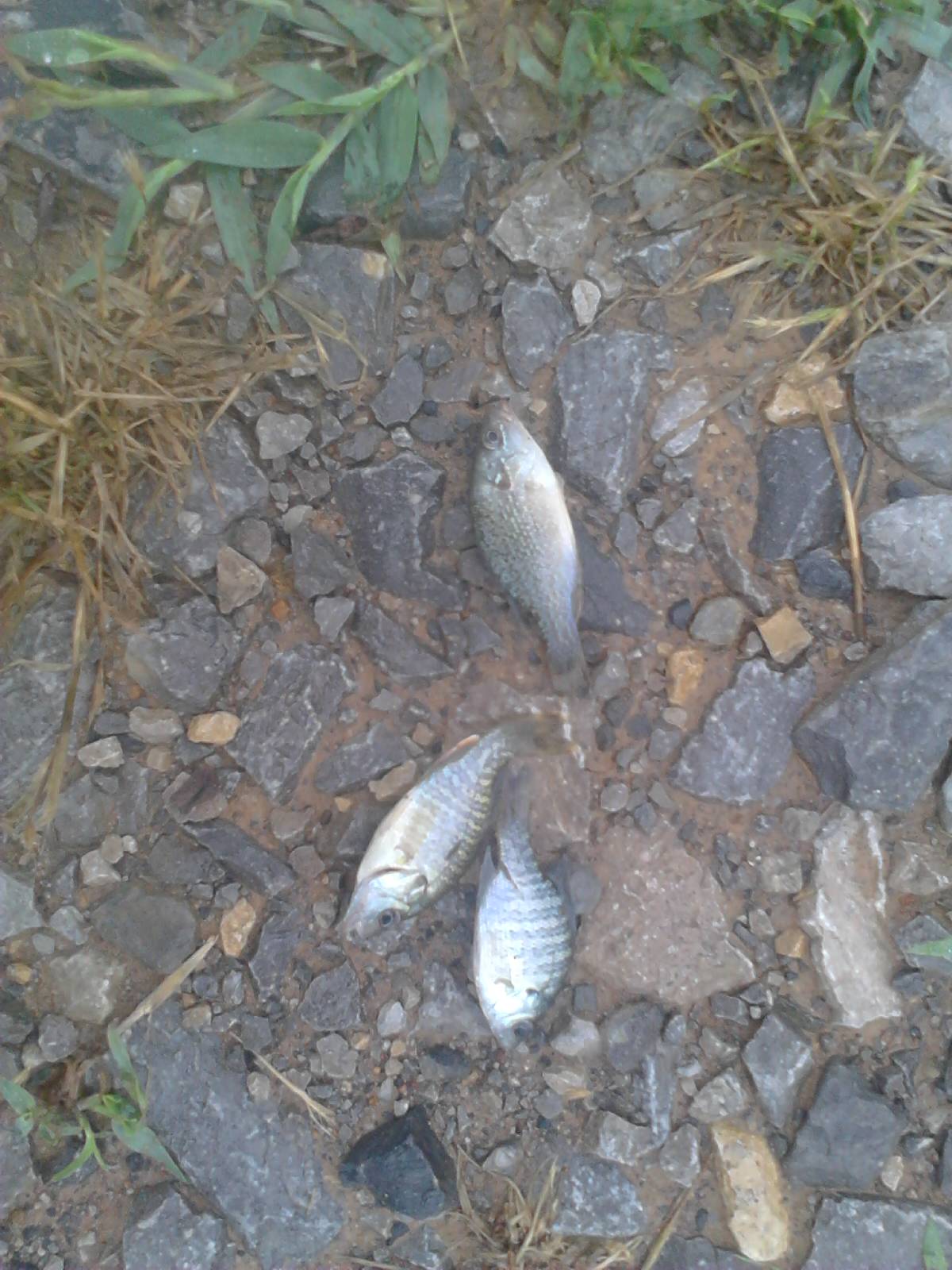

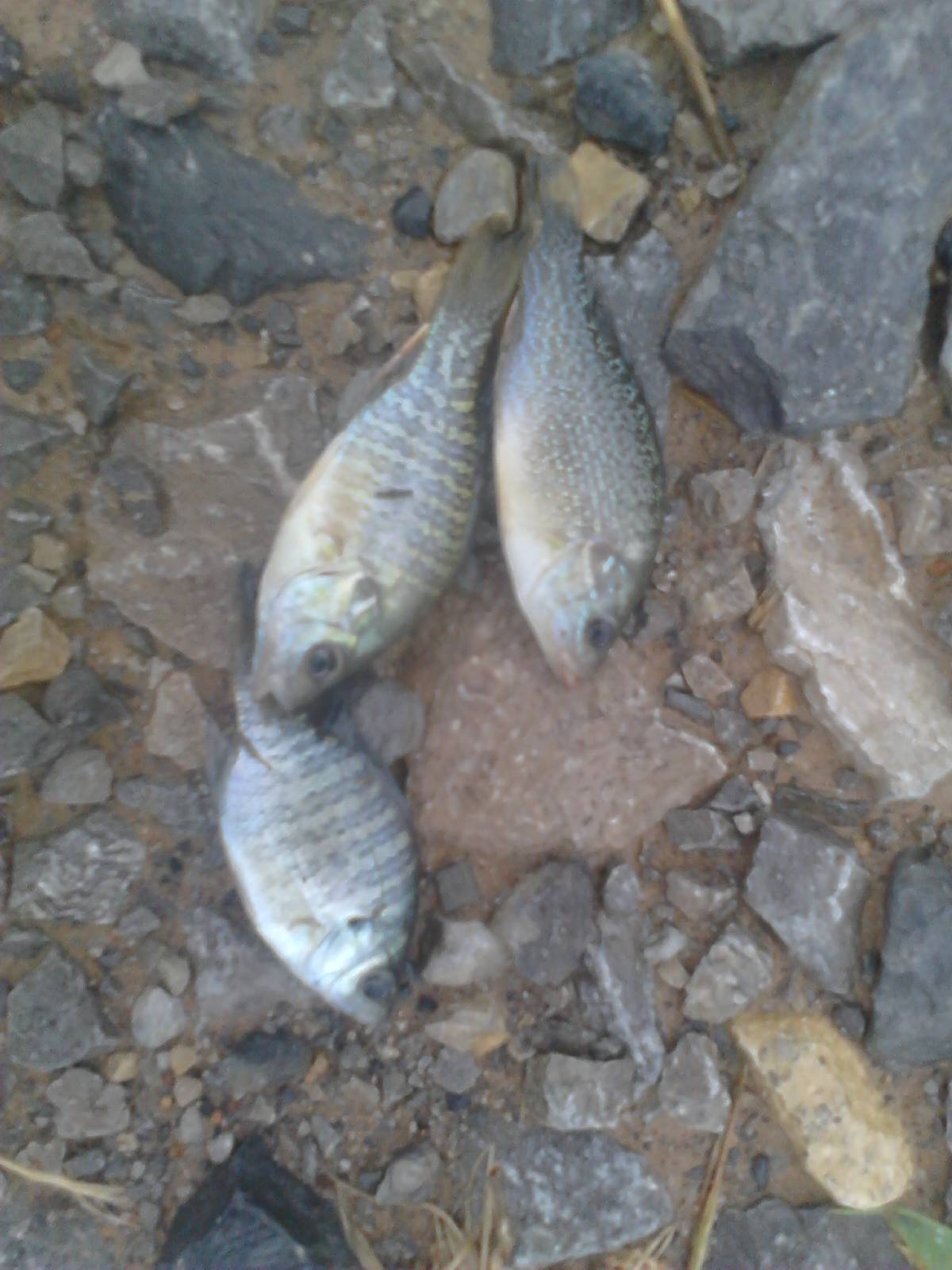

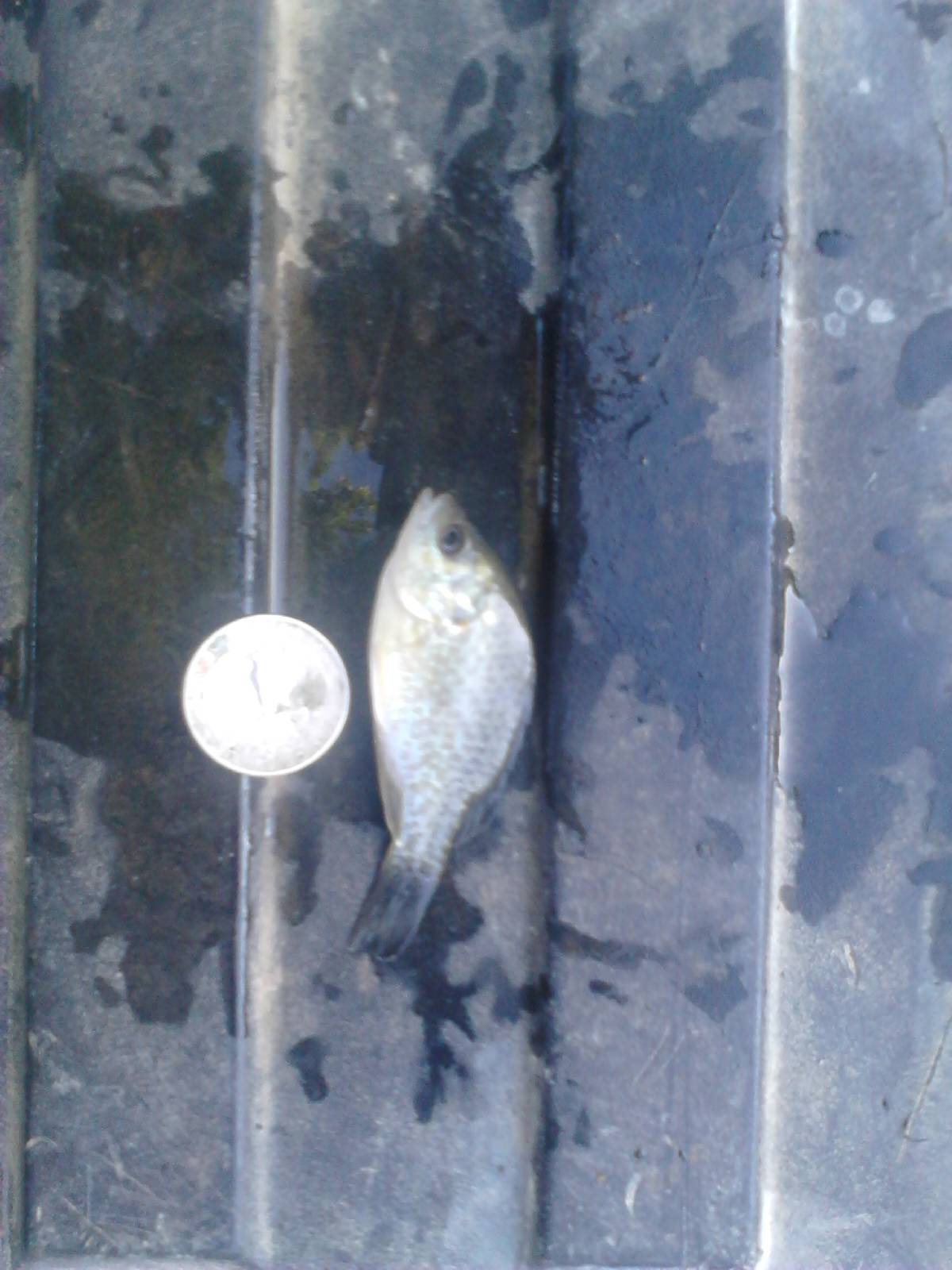
These three fish came out of my sediment pond where I am getting a significant number of natural HBG spawn. I get the rare GSF fingerling, quite a few more of the HBG, a few RES, and lots and lots of CNBG from the original CNBG and RES stocked in this 1/10th acre sediment pond.
I will tell what I believe the fish to be in the first picture based on what I see. Then let the experts correct or add to my description of what they think they are. The rest of the pictures will be of the same three fish but in different order because they kept jumping around while I was trying to get pictures. My phone is an old one and does not take the greatest pictures, but I like using it because I do not have to resize them to get them to upload.
First picture the top fish is a BG (likely CNBG because that is what is stocked in this pond, but high water events do let my small northern BG swim up the overflow so the potential is there for it to be a regular BG but odds are against it).
First picture middle fish is one of a significant number of naturally occurring HBG I am getting from this pond. There were a few GSF snuck into this pond (I have caught a few adults) and have spawned with a BG. It is harder to tell from this picture on some of the features I will describe, but in person they were more evident. The mouth size of this fish is intermediate from the top and bottom fish. It has the vertical bars of a BG but notice the more elongated shape than the top BG. On the opercular tab there is a slight orange translucent border showing GSF influence as well as some less defined green bars below the eye reminiscent of a GSF.
First picture bottom fish is a classic GSF that I have seen and trapped hundreds that look exactly like this one from my old pond. More fusiform elongated shape, Large mouth compared to a BG (closer to the size of a LMB of that size), distinct green bars on the mouth area under the eye, No vertical bars except for the slight amount near the top of the fish. If you look closely, the bluegreen flecks the GSF is known for its coloration are actually lined horizontally. Though they are very small, there will be a horizontal line of mostly green flecks alternating with lines composed of the other colors of the fish. Notice the tinted lower fins, in this case reddish. Sometimes I also see a yellow tint to the fin borders on the larger GSF. Never see a tinted border on regular BG, although my larger CNBG tend to have a white border tint. But never reddish or yellow.
All the remaining pictures are the same fish (but not in the same order as they were jumping around) for more angles of view. Wish I was a professional photographer so the pics were better than they are. But I think you can see most of the differences in the fish. I also wish I would have had a fingerling RES and LMB in the same picture.
I'm guessing the fish to be about 2.5" long. This size readily goes into a standard 1" opening minnow trap. The high water from recent rains raised the water up enough so these fish along with a few others went in this trap that was left on the bank the night before. When I saw the three different fish together........... photo op!
I welcome additions and corrections to my descriptions.
Edit: notice the last picture description which was added later. RES pictures further down the thread in another post. Second edit: After seeing hundreds of both pure RES and RESxGSF hybrids, the picture is definitely a hybrid. I have raised these up to 8" now and the hybrid is more evident as the fish get older. Green bars on the cheeks are one giveaway.
Description: BG top, HBG middle, GSF bottom
Description: RES or possibly GRES (GSF/RES hybrid) caught later in different pond
